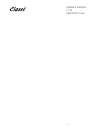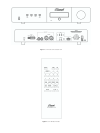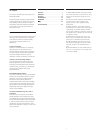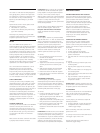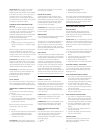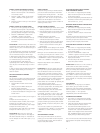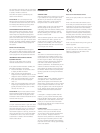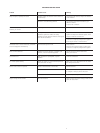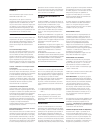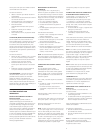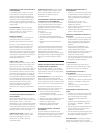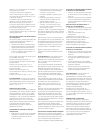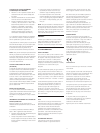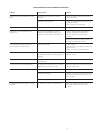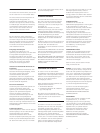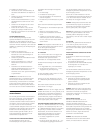
5
This procedure will continue until the entire band
has been scanned or 30 stations have been saved
as presets, whichever comes first.
Select AM and repeat to automatically save
stations in the AM band.
PLEASE NOTE: You can interrupt the Auto
Memory process by pressing the FM-AM button
on either the remote or the front panel. You can
also interrupt Auto Memory by turning off the
CT-10 from the remote or front panel.
STEREO-MONO BUTTONS AND DISPLAY
Most FM stations will be received in stereo if
their signal is strong enough. Weaker stereo
stations may be accompanied by background
noise. Press the Mono-Stereo button on the front
panel or the Mono button on the remote control
to reduce this noise. Press again to resume stereo
listening. The display indicates STEREO or MONO
for FM stations. MONO is always displayed for
AM stations.
RADIO DATA SYSTEM (RDS)
The CT-10 can display the Radio Data System
(RDS). A station’s RDS information might include
its call letters, its format, information about the
current program and the present date and time.
INFORMATION ABOUT RADIO STATIONS
EQUIPPED WITH RDS
Tune into a radio station with one of the
methods described earlier in this manual.
If the station has RDS information available, the
letters RDS will appear in the display.
• Press the RDS button on the remote control
to display the RDS information.
• When you first press the RDS button,
Program Service is displayed under PS. PS will
display the station’s call letters, such as KPFA.
• When you press the RDS button a second
time, clock time and date are displayed
under CT.
• When you press the RDS button a third time,
Program Type is displayed under PTY. This is
typically the station’s format, such as Public,
Classical, Jazz, Rock, etc.
PLEASE NOTE: Very few radio stations in North
America broadcast with the RDS system. Many
stations don’t broadcast all categories of RDS
information. More information about RDS can be
found at www.rds.org.uk.
CONTACTS
Call your Classé Audio dealer or your local Classé
Audio distributor. A problem can often be solved
with simple diagnostic tests you can perform by
yourself. If we determine that your CT-10 will
need further inspection or servicing, the unit will
need to be returned to your Classé Audio dealer
or distributor for service. You can also contact
Classé Audio in Canada at 514 636 6384 to
obtain contact details.
RECEPTION AND PERFORMANCE
INFORMATION
ANTENNA CABLE
Often the cable from your antenna to your tuner
is your weakest link in your FM system. Some
attention in your selection of cable will yield
dramatic results when it comes to reducing
background noise on weak FM stations.
A better quality 75-ohm coax cable will provide
efficient passage of the signal and, most
importantly, offers more effective shielding of the
cable against external interference. Without
effective shielding your coax cable can in fact
become an antenna itself.
There are different grades of 75-ohm coax cable.
There is RG59/U (this cable is good for runs
50 feet and less.) and there is RG6. RG6 is our
preference as its shielding is of much higher
quality than RG59/U. RG6 also has lower losses
in runs longer than 100 feet.
ANTENNA TYPES
YAGI
This antenna is a multi-element design that is
unidirectional and is capable of pulling in very
distant stations due to its high gain, the higher
the level of gain the better. These Yagi types of
antennae are highly directional and should be
used with a rotor control to optimize the
antenna’s performance. The directionality of this
antenna also aids the elimination of any multi-
path problems, by allowing only the signal from
the direction that the antenna is pointing while
ignoring signals that are coming from different
directions.
VERTICLE
1
/
2
WAVE
This design offers ease of installation, placement
and operation. Omni – directional antennas
gather the FM signals from all directions (360
degree radius), meaning that no rotor is required
to pull in stations from behind or the side. This
design also gathers more of the FM signal from
the air, offering superior fidelity over that of a
standard bi-directional antenna (mentioned
below).
If multi-path is a reception problem with this
antenna, try to lay it down horizontally rather
than the standard vertical position. This antenna
is effective both in and outdoors; however, the
higher you can place this antenna the better.
Also placing this antenna near a window will aid
in better reception quality.
FOLDED DI-POLE
This is the most common and simplest of all
antennas, most of you are familiar with the
79 cent piece of wire (generally provided with a
tuner or receiver). This piece of wire is bi-
directional and its performance is affected by the
angle the signal is received by this wire. There
are quite a number of DI-POLE antenna designs;
they work well in areas of strong signal strength,
such as local stations.
Notice to all Classé Product owners:
Thank you for your purchase of a Classé Audio
component.
All of us at Classé have taken extreme care to
ensure that your purchase will become a prized
investment. We are proud to inform you that all
Classé Audio components have been officially
approved for the European Community CE mark.
This means that your Classé product has been
subjected to the most rigorous manufacturing
and safety tests in the world, and has proven to
meet or exceed all European Community CE
requirements for unit to unit consistency and
consumer safety.
All of us at Classé Audio wish you many years of
musical enjoyment.
As of July 18, 1996, Classé Audio has been
granted Certificate No: C401CLA1.MGS, which
indicates CE Approval for all models of the
Classé Audio product line.



